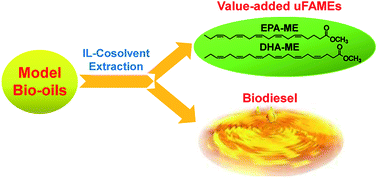Separation of highly unsaturated fatty acid methyl esters from model bio-oils with ionic liquid-cosolvent as extractants†
Abstract
The effective separation and utilization of high value-added unsaturated fatty acid methyl esters from model bio-oils could make full use of the biomass resources and greatly improve the economic feasibility of bio-fuels. Selective separation of unsaturated fatty acid methyl esters was performed by liquid–liquid extraction, using ionic liquids (ILs) as extractants in the presence of cosolvent. The results showed that the mixture of 1-ethyl-3-methylimidazolium dicyanamide ([EMIm][N(CN)2]) and N,N-dimethylformamide (DMF) demonstrated excellent separation selectivity, reaching up to an outstanding value of 11.7, when the mole ratio of [EMIm][N(CN)2] to DMF was 1 : 9, at least twice the value (5.6) using DMF as the extractant. In addition, the effects of the structure, the mole fraction of ILs, the feedstock concentration and temperature, on extraction equilibrium were studied. By calculating the fractional extraction, the feasibility of liquid–liquid extraction for practical application was confirmed.


 Please wait while we load your content...
Please wait while we load your content...